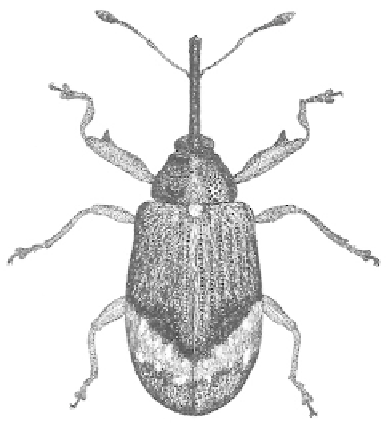Agriculture Reference
In-Depth Information
DESCRIPTION
Adult
2.5-3.5 mm long, mainly black; elytra
bluish-black, with a metallic sheen.
Egg
0.45 mm long, oval, yellowish.
Larva
up to
4 mm long;
body
translucent to creamish-white;
head
black.
Pupa
3.0-3.5 mm long, whitish,
translucent.
feed on the opening buds of apple trees. The
weevils become sexually mature within a couple
of weeks and mating then takes place. Soon af-
terwards, eggs are laid singly in the developing
floral buds. The eggs hatch about 7-10 days later.
Each larva feeds on the anthers and style, and
also bites into the base of the petals to arrest
their development. Larvae are fully grown in
about a month. Each then pupates within the
now empty shell of the capped blossom; the new
adult emerges 2-3 weeks later, usually in June.
Young adults feed on the foliage for a short time.
They then seek suitable overwintering sites,
under bark or leaf litter or in other sheltered
situations such as piles of logs or fallen timber.
Apion pomonae
(F.)
Vetch seed weevil
Adults of this widely distributed weevil occur
from late May onwards. They infest various
kinds of Fabaceae, including vetch seed crops.
Eggs are laid from mid-June onwards at the early
flowering stage, each being inserted into a devel-
oping pod through the base of a flower or flower
bud, often several eggs per pod. Larvae feed on
the developing ovules and eventually pupate
between two of the seeds. New adults appear
from August onwards. Adults are 2.8-3.5 mm
long, with a black or bluish-black head and tho-
rax, blue or greenish-blue, somewhat downy,
elytra and black legs.
DESCRIPTION
Adult
3.5-6.0mm long, mainly black, with grey-
ish and whitish hairs imparting a mottled pattern
and a characteristic V-shaped mark over the
elytra
(Fig. 226). Egg
0.7 x 0.5mm, oval, white
and translucent.
Larva
up to 8 mm long;
body
white to yellowish
(Fig. 227a);
head
dark brown
or blackish.
Pupa
4-5 mm long, pale yellow,
with a pair of prominent posterior spines,
and distinct wing pads and other appendages
(Fig. 227b).
Family CURCULIONIDAE (weevils)
Anthonomus pomorum
(L.)
Apple blossom weevil
The apple blossom weevil is a potentially impor-
tant pest; in addition to apple, minor attacks may
also occur on medlar, pear and quince. Larvae
feed within the shelter of unopened blossoms,
the petals of which turn brown to produce the
characteristic 'capped blossom'. Minor infesta-
tions are of little or no significance but when
attacks are heavy, considerable crop losses may
be expected and all but the most advanced blos-
soms on the tree may be destroyed. Adults feed-
ing on buds or foliage have little deleterious
effect, except on pear where attack buds can
become distorted and may shrivel and die.
BIOLOGY
Adult weevils emerge from hibernation in the
early spring, usually from February onwards, to
Fig. 226 Apple blossom weevil,
Anthonomus
pomorum
(x!5).

